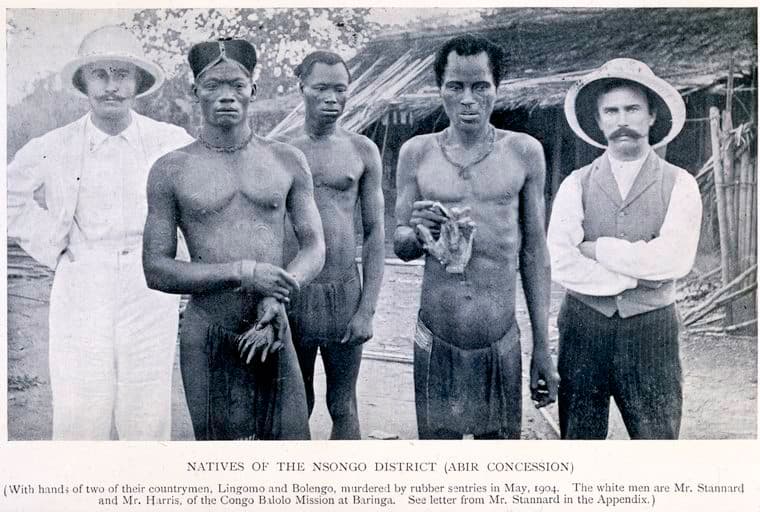Background Information: Men of the Nsongo District (ABIR concession) with hands of two of their countrymen Lingomo and Bolenge murdered by rubber sentries of ABIR Anglo-Belgian India Rubber Company in May 1904. The two European men are Mr. Stannard and Mr. Harris of the Congo Balolo Mission at Baringa. This image formed part of the Harris Lantern Slide Collection. Under King Leopold II the Congo Free State used mass forced labour to extract rubber from the jungle for the European market. As consumer demand grew King Leopold II’s private army – the Force Publique – used violent means to coerce the population into meeting quotas, including murder, mutilation, rape, village burning, starvation and hostage taking. Alice Seeley Harris and her husband Reverend John H. Harris were missionaries in the Congo Free State from the late 1890s.

Background Information: This 1904 photograph is by Alice Seeley Harris, the man’s name is Nsala. Here is part of her account (from the book “Don’t Call Me Lady: The Journey of Lady Alice Seeley Harris”): He hadn’t made his rubber quota for the day so the Belgian-appointed overseers had cut off his daughter’s hand and foot. Her name was Boali. She was five years old. Then they killed her. But they weren’t finished. Then they killed his wife too.
And because that didn’t seem quite cruel enough, quite strong enough to make their case, they cannibalized both Boali and her mother. And they presented Nsala with the tokens, the leftovers from the once living body of his darling child whom he so loved. His life was destroyed.
They had partially destroyed it anyway by forcing his servitude but this act finished it for him. All of this filth had occurred because one man, one man who lived thousands of miles across the sea, one man who couldn’t get rich enough, had decreed that this land was his and that these people should serve his own greed. Leopold had not given any thought to the idea that these African children, these men, and women, were our fully human brothers, created equally by the same Hand that had created his own lineage of European Royalty.

Questions:
- What do you think was Alice Seeley Harris’ intention in taking these images? How do you think she gained access to take and share these photos?
- Imagine you were alive during this time. How might you respond to each of these images? Would your perspective change if you were Belgian?
- What do you think the posing of the subjects in the images shows us about the interactions between the photographer and the subjects?
Instructional Goals and Model Answers:
The learners will evaluate the photographs along with their understanding of the time and place they were taken. The learner will explain their perspective on the intentions of the photographer and their access to the subjects.
- Alice Seeley Harris was a missionary in the Belgian Congo. Her position as a missionary might have helped her gain access to take these photos. I believe her intention in taking these photographs was to show the inhumanity happening at that time. What was happening must have seemed very far away from Europe at that time, so her intention may have been to show that this evilness was occurring and was real.
- It might have been difficult at the time for someone to believe that these images were real, especially someone who was Belgian. They may not have wanted to face or accept the fact that the rubber industry was this horrible.
- It’s difficult to imagine the circumstances in which these photographs were taken. Alice Seeley Harris had to have been standing in front of these people. I wonder what she said to them in order for them to let her take their picture, especially the guards, and how they must have compartmentalized and dehumanized the Congolese people in order to do what they did. The second photograph is incredibly powerful, made even more so by the framing. Nsala’s devastation and emptiness is felt by the viewer.

You document a very inhumane and disturbing aspect of Belgian colonial rule. This would be difficult material for students to process. So it would need to be handled carefully. Your questions help contextualize the shocking images and the interactions of the photographer and her subjects.
At the same time it highlights the role these crusading photographs played in exposing these shocking atrocities. One method might be to explore Harris’ role as an early documentarian using photography to foster a human rights campaign. Her efforts could be contrasted with contemporary campaigns.